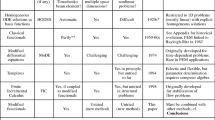Summary
This article presents a survey of the Core-Congruential Formulation (CCF) for geometrically nonlinear mechanical finite elements based on the Total Lagrangian (TL) kinematic description. Although the key ideas behind the CCF can be traced back to Rajasekaran and Murray in 1973, it has not subsequently received serious attention. The CCF is distinguished by a two-phase development of the finite element stiffness equations. The initial phase develop equations for individual particles. These equations are expressed in terms of displacement gradients as degrees of freedom. The second phase involves congruential-type transformations that eventually binds the element particles of an individual element in terms of its node-displacement degrees of freedom. Two versions of the CCF, labeled Direct and Generalized, are distinguished. The Direct CCF (DCCF) is first described in general form and then applied to the derivation of geometrically nonlinear bar, and plane stress elements using the Green-Lagrange strain measure. The more complex Generalized CCF (GCCF) is described and applied to the derivation of 2D and 3D Timoshenko beam elements. Several advantages of the CCF, notably the physically clean separation of material and geometric stiffnesses, and its independence with respect to the ultimate choice of shape functions and element degrees of freedom, are noted. Application examples involving very large motions solved with the 3D beam element display the range of applicability of this formulation, which transcends the kinematic limitations commonly attributed to the TL description.
Similar content being viewed by others
References
S. Rajasekaran and D. W. Murray, “Incremental finite element matrices”,J. Str. Div. ASCE,99, pp. 2423–2438, 1973.
R. H. Mallet and P. V. Marcal, “Finite element analysis of nonlinear structures”,J. Str. Div. ASCE,94, pp. 2081–2105, 1968.
D. W. Murray, “Finite element nonlinear analysis of plates”, Ph. D. Dissertation, Dept. of Civil Engineering, University of California, Berkeley, California, 1967.
C. A. Felippa, “Discussion of Reference 1”,J. Str. Div. ASCE,100, pp. 2519–2521, 1974.
L. A. Crivelli, “A Total-Lagrangian beam element for analysis of nonlinear space structures”,Ph. D. Dissertation, Dept. of Aerospace Engineering Sciences, University of Colorado, Boulder, CO, 1990.
C. A. Felippa and L. A. Crivelli, “A congruential formulation of nonlinear finite elements”, inNonlinear Computational Mechanics—The State of the Art, ed. by P. Wriggers and W. Wagner, Springer-Verlag, Berlin, pp. 283–302, 1991.
L. A. Crivelli and C. A. Felippa, “A three-dimensional non-linear Timoshenko beam element based on the core-congruential formulation”,Int. J. Numer. Meth. Engrg.,36, pp. 3647–3673, 1993.
K. Mathiasson, A. Bengtsson and A. Samuelsson, “On the accuracy and efficiency of numerical algorithms for geometrically nonlinear structural analysis”, inFinite Element Methods for Nonlinear Problems, ed. by P. G. Bergan, K. J. Bathe and W. Wunderlich, Springer-Verlag, Berlin, pp. 3–24, 1986.
P. G. Bergan and K. M. Mathisen, “Large displacement analysis of highly flexible offshore structures”, inNonlinear Computational Mechanics—The State of the Art, ed. by P. Wriggers and W. Wagner, Springer-Verlag, Berlin, pp. 303–331.
S. Alexander, H. M. de la Fuente and B. Haugen, “Correspondence between CC-TL and C-TL formulations: A 2D Timoshenko beam element using the Total-Lagrangian Core Congruential Formulation”, inTerm Projects in Nonlinear Finite Element Methods, ed. by C. A. Felippa, Report CU-CSSC-91-12, Center for Space Structures and Controls, University of Colorado, Boulder, CO, May 1991.
F. Abedzadeh Anaraki, A. Barzegar Mehrabi and H. R. Lofti, “Correspondence between CC-TL and C-TL formulations”, inTerm Projects in Nonlinear Finite Element Methods, ed. by C. A. Felippa, Report CU-CSSC-91-12, Center for Space Structures and Controls, University of Colorado, Boulder, CO, May 1991.
K. M. Mathisen, “Large displacement analysis of flexible and rigid systems considering displacement-dependent loads and nonlinear constraints”,Dr. Ing. Thesis, Div. of Structural Mechanics, The Norwegian Institute of Technology, Trondheim, Norway, 1990.
K. J. Bathe and S. Bolourchi, “Large displacement analysis of three-dimensional beam structures”,Int. J. Numer. Meth. Engrg.,14, pp. 961–986, 1979.
J. C. Simo and L. Vu-Quoc, “A three-dimensional finite strain rod model. Part II: Computational aspects”,Comp. Meths. Appl. Mech. Engrg.,58, pp. 79–116, 1986.
A. Cardona, “An integrated approach to mechanism analysis”,Ph. D. Dissertation, LTAS, Université de Liège, Belgium, 1989.
V. V. Bolotin,Nonconservative Problems of the Theory of Elastic Stability, Pergamon Press, New York, 1963.
H. Ziegler,Principles of Structural Stability, Blaisdell, Massachusetts, 1968.
A. E. H. Love,The Mathematical Theory of Elasticity, Dover, New York, 1944.
B. Nour-Omid and C. C. Rankin, “Finite rotation analysis and consistent linearization using projectors”,Comp. Meths. Appl. Mech. Engrg.,93, pp. 353–384, 1991.
B. Haugen, “Buckling and stability problems for thin shell structures using high-performance finite elements”,Ph. D. Dissertation, Dept. of Aerospace Engineering Sciences, University of Colorado, Boulder, CO, 1994.
O. C. Zienkiewicz,The Finite Element Method, 3rd ed., McGraw-Hill, London, 1976.
Author information
Authors and Affiliations
Rights and permissions
About this article
Cite this article
Felippa, C.A., Crivelli, L.A. & Haugen, B. A survey of the core-congruential formulation for geometrically nonlinear TL finite elements. ARCO 1, 1–48 (1994). https://doi.org/10.1007/BF02736179
Received:
Issue Date:
DOI: https://doi.org/10.1007/BF02736179




